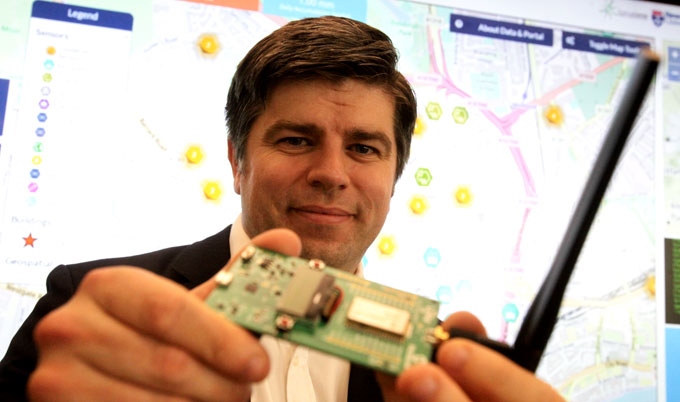USB
Science of sensing
Published on: 13 September 2017
UK’s first Urban Observatory provides unique understanding of how our cities work
Hundreds of sensors deployed across Newcastle and Gateshead are providing us with a digital view of the interactions in our cities and the impact climate change might have on them.
Collecting over half a billion data points so far, Newcastle University’s Urban Observatory is now starting to shed light on the way different systems interact across our city and provide a baseline against which future cities can be developed and managed.
Collecting data about everything from energy use, rainfall and flooding to air pollution, traffic and even tweets, the aim is for the data to be used by planning authorities, infrastructure operators, emergency services and community groups to help them make better informed decisions about how conditions in the city could affect them.

UK’s largest set of real-time, urban data
Funded by Newcastle University and UKCRIC – the UK Collaboratorium for Research on Infrastructure and Cities – which is overseen and funded by the Engineering and Physical Sciences Research Council, the Urban Observatory is based in Newcastle University’s newly-opened Urban Sciences Building on Science Central.
"By 2050, around 70 per cent of the world’s population will live in cities, but there is so much we don't fully understand - why do some things we do in cities work while others fail?" says Professor Richard Dawson, who leads the Newcastle UKCRIC programme.
"By compiling observations and comparing the data, for the first time we are now able to make more informed decisions about designing our infrastructure and cities to work better for people and the environment.”
Evidence-based decisions
Creating a city-wide network of sensors, the key objective is to capture the complex interrelations and interactions between buildings and infrastructure, people and the natural environment.
Covering both in the city centre and the suburbs, the sensor network includes 100 sensors in the new Sustainable Urban Drainage Lab (SUDs) on Science Central, a dedicated facility that will undertake research into urban flood management to develop and test new approaches to managing the impact of extreme weather events, such as the floods of Thunder Thursday in 2012.
More than 1,000 sensors are also embedded in the Urban Sciences Building – the University’s ‘building as a lab’ and the central hub for the Urban Observatory. Connecting walls, windows and fittings, these sensors are measuring everything that comes into the building and everything that leaves it, helping researchers design more efficient, sustainable and resilient buildings for the future.
Phil James, who co-leads the Urban Observatory research, explains:
“Cities are complex environments and if we want to develop them sustainably then we have to understand how everything interacts.
“For example, when it rains heavily more people get into their cars and the traffic moves slower which increases air pollution. At the same time, the drains fill and flood certain areas of the city bringing traffic to a standstill, impacting further on air pollution, but also impacting on the energy and communication networks, on the emergency services and so on. It’s like a ripple effect both geographically and also across infrastructures and services.
“If we try to solve one problem in isolation – such as flooding – then we don’t know what impact that will have on everything else.
“So to be able to make informed, evidence-based decisions about the future development and management of our cities we need a baseline to work from and that’s what we’re doing for the first time here in Newcastle through the Urban Observatory.”
Addressing the major challenges
UKCRIC is a network of 14 universities and partner organisations working together to better understand and address the challenges that face the essential networks and services our cities depend on.
At Newcastle University, the £12m project will also include an Electric Vehicle Filling Station Research Facility at Science Central. This is one of the UK’s first EV rapid charge stations that will allow cars to be re-charged in as little as 20 minutes. This will be linked to the Energy Storage Test Bed and Smart Grid laboratory at the University’s £20m National Centre for Energy Systems Integration (CESI) to tackle the engineering challenges of integrating energy and transport systems in cities.
The Urban Sciences Building is a £58m ‘living lab’ and an exemplar of sustainable urban architecture. Based on Science Central, it is also the new home to the University’s School of Computing and opens its doors to students for the first time this month.
Demonstrating world-leading research and innovation in a real-world environment, Science Central is a full scale, city-centre demonstrator of how we can integrate infrastructures - water, energy, transport, climate adaptation and digital technology – to create the smart and sustainable city of the future.
The development is a partnership between Newcastle University, Newcastle City Council and Legal & General Capital.
Analysing some of the first data collected through the Urban Observatory, the Newcastle team have shown that levels of NO2/NO in Newcastle city centre exceeded yearly average government target for an average of 18 hours a day, every day, throughout July 2017.
Using data taken from the sensor situated at the top of Northumberland Street and mapping the day by day data for July, the team were also able to identify anomalies.
“On the first Sunday of the month we see a drop in NO2 to almost zero,” says Phil James.
“This coincides with the HSBC British Cycling City Ride which closed five miles of road in the city centre to cars.
“It won’t come as a surprise to anyone that if you keep the cars out of the city the air pollution drops but with the Urban Observatory we can prove it and compare this alongside the other data to see what the ripple effect across the system has been.”



